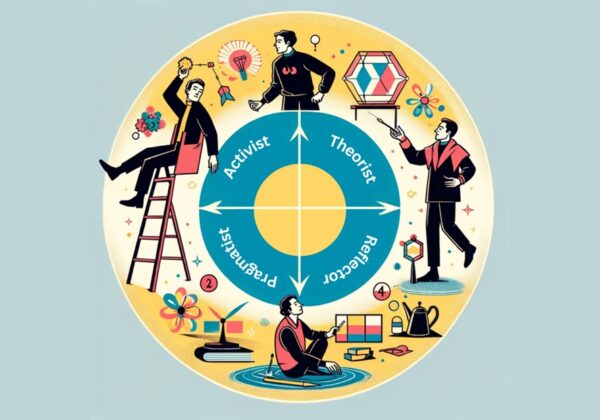🏢 9,000+ Organisations
🏆 6 x L&D/HR Awards
⭐ 4.8/5 Highly Rated
🧠 24 Years' Experience

Have you ever come across or explored the Honey and Mumford Learning Cycle?
This pivotal model, formulated by Peter Honey and Alan Mumford, sheds light on distinct learning styles that each individual may embody.
It’s no surprise that the model is frequently covered in management training courses, given its significance.
Recognising and harnessing these styles can significantly cater to the varied needs of learners!
Let’s delve deeper into how this cycle can revolutionise the way you approach your training and development.

Through their research, Honey and Mumford identified four different approaches people take when learning new information:
They argued that most people either stick to one of these styles or vacillate between two in different types of scenarios.
Honey and Mumford’s work was inspired by David A. Kolb’s learning styles.
However, they found that the Learning Styles Inventory (or LSI) Kolb used was not relevant to managers, so they decided to create their own, which they dubbed a Learning Styles Questionnaire (or LSQ).
Kolb’s LSI involves directly asking people how they learn. Honey and Mumford’s questionnaire, on the other hand, focuses on general behaviours and tendencies.
The Honey and Mumford Learning Cycle consists of four styles that feed into each other:
Honey and Mumford posit that these learning styles exist on a continuum and that people move through this continuum over time.
The journey across the continuum looks like this:
Eventually, after going through all these different phases, the learner comes to prefer and rely on one or two learning styles most of the time.
It’s important to note that no one learning style is inherently better than the other, and they all build off each other.
There are strengths and drawbacks associated with each one, and a diversity of learning styles can allow for better team performance.
One of the biggest determinants of your success as a leader is the performance of your team. Check out these 5 Tips for Managers to Improve Their Team’s Performance.
To figure out which learning style (or styles) is most applicable to you and your team members, you must understand the nuances of each one.
Here is a breakdown of Mumford and Honey’s four styles:

Activists prefer an “active” approach and learn by doing.
They enjoy new experiences and are typically eager to jump right in and get their hands dirty. They may also experience impulse control issues and act before fully considering the consequences.
Activists typically respond well to competitions, are excellent problem-solvers, and are eager to participate in brainstorming activities.
If you can identify any Activist Learners in your team, why not try out some of these Team Building Problem-Solving Activities with them!

Reflectors don’t like to participate while they are learning. They’d prefer to sit and watch first, let the information absorb, plan their own course of action, and then implement the new techniques they’ve learned.
These people learn through observation and like to take in information from multiple perspectives before they reach a conclusion. They often struggle when they feel rushed or don’t have enough time to prepare.
Reflectors typically respond well to feedback from others and are good at demonstrating a more coaching style approach with their fellow team members.

Theorists prefer models, theories, and anything that presents an idea in an organised fashion. The models don’t even have to be realistic as long as they make a point.
Understanding the theory and motivation behind actions is vital for theorists. They need time to analyse and synthesise testable hypotheses before they come to a conclusion.
These individuals may struggle with more feelings-based work or in situations when instructions or objectives are unclear.

Pragmatists, as the name suggests, are all about the practical. They need to understand how what they’re learning applies in the real world.
These learners search for realistic examples that relate directly to the task at hand. They don’t want to waste time with hypothetical situations when they could be learning how to apply something directly to their own job tasks.
Like Theorists, pragmatist leaders may also struggle when objectives or instructions are unclear. Discussions that are too theoretical and don’t seem grounded in reality can also be tricky.
As a leader, it’s critical that you not only acknowledge that people have different learning styles but also take the time to understand the way each of your team members learns and interprets the world.
If you put in the effort to understand these things, you, your team, and the company will benefit in the following ways:
There’s no point in dedicating time and resources to employee training if the materials aren’t effective and don’t actually help team members gain new skills, understand new concepts, etc. When you take people’s preferred learning style(s) into account, they’re more likely to retain the information shared during the lesson and implement it into their day-to-day workflows.
Looking to re-energise & refocus your team? Check out MTD’s Team Building Training.
If you learn new employees’ learning styles at the beginning of their journey at your company, you can set them up for success right from the start. Providing onboarding training in a way that best aligns with someone’s learning style can help them settle into their role and start performing at a higher level sooner.
When people pick up new concepts and skills more quickly, they can also start executing them sooner. In many cases, this scenario will lead to increased productivity, less wasted time, and better overall performance.
Employees are more likely to feel appreciated and respected if you take the time to train and coach them in a style that aligns with their behaviours and tendencies. Rather than feeling like they’re a square peg being forced into a round hole, they’ll see that you care about their success and want to help them achieve their goals.
Better morale in the workplace typically results in improved retention rates. If employees feel respected by their leader or manager, they’ll be less likely to look for other jobs and jump ship as soon as a new opportunity arises.
When employees understand each other’s learning styles, they’ll have an easier time empathising, seeing where the other person is coming from, and working together to complete tasks and projects.
Remember, if you’re leading, it’s really important to understand that everyone learns differently. Make sure you take a bit of time to figure out how each person on your team ticks and sees things. For a boost in getting it right, consider diving into our team leadership training.

How can you take what you’ve learned about the Honey and Mumford model and apply it to your team? Here are some practical tips you can start implementing today:
Use the Honey and Mumford Learning Styles Questionnaire to get to know your employees better. Ask everyone to complete the assessment so they can understand their approach to learning better and share that information with you and other leaders, managers, etc.
Once you know how different members of your team learn, you can start tailoring employee training modules and other resources to those different learning styles.
For example, you might offer an option for Activist learners that involves brainstorming and working as a group. You might also provide a more practical resource with lots of real-world examples for Pragmatist learners.
Keep people’s learning styles in mind when assigning tasks and responsibilities. For example, asking a Theorist learner to complete a task that has a fast-approaching deadline might not be the best idea, but an Activist learner could probably take it on without any issues.
Maybe you don’t have the time to create new learning materials from scratch. The good news is that you don’t have to. Many digital learning solutions can simplify this process and help you deliver training modules in various formats to cater to multiple learning styles through one platform.
As a leader, you know the importance of getting honest feedback from your employees when making decisions and planning for the future.
Be sure to solicit feedback about your utilisation of the Honey and Mumford model and do your best to be open to suggestions on how you can be more effective in the way you deliver information, conduct assessments, etc.
How do the learning styles of Honey and Mumford look in practice?
Here are some real-world examples that can help you further understand the theory and apply it to your employees:

During a team meeting, you’ll likely find an Activist learner actively participating in the discussion and brainstorming new ideas.
They won’t shy away from a debate and are happy to act out and work through different scenarios.

In the same team meeting, while the Activist is playing a more active role, the theorist is more likely to be doing in-depth research, looking for papers, academic articles, and other resources that can help them understand a particular topic.
They will also be looking for ways to apply what they’re learning to the situation being discussed during the meeting.

At first glance, a reflector might look like they’re not super engaged in a team meeting because they’re busy writing and reviewing information. In reality, they’re simply taking things in in a way that is more effective for them.
They’re highly reflective and introspective, making them valuable assets when it comes to breaking down the finer points of a plan, identifying potential challenges, etc.

During a team meeting, pragmatists will be looking for ways to apply what they’ve learned during training sessions and workshops to the current situation.
They will be coming up with real-world examples, drawing on case studies and past experiences, to help the team come up with and effectively execute a plan.

The Honey and Mumford theory certainly has similarities with other educational models. It also has important distinctions, though. The following are some popular learning models that those who consider using the Honey and Mumford model also utilise:
Kolb’s Learning Styles and Honey and the Mumford Learning Cycle, naturally, have a lot in common. They both feature four learning styles and use a cyclical framework, for example. Honey and Mumford are even quoted as saying,
“The similarities between his model and ours are greater than the differences.”
The four learning styles outlined in Kolb’s theory are as follows:
One of the primary differences between the two theories is their application, as the Honey and Mumford model is geared more toward managers and leaders in the workplace.
The VAK model breaks learning styles into three categories:
Every person is capable of learning through all of these styles, but they have a tendency toward one over the others.
Unlike the four learning styles outlined in the Honey and Mumford Cycle, Howard Gardner’s multiple intelligences theory suggests there are seven different types of intelligence:
The Honey and Mumford Learning Cycle is a valuable tool for understanding how people learn.
Once you know how different people on your team take in information, you can adapt your approach to ensure you’re giving them the support they need to excel in their position and help the team (and the company) achieve its goals.
Do you want to learn more about the Honey and Mumford model or other learning models? If so, MTD offers a variety of courses, like our management skills course.
We also offer a supervisor course and bespoke leadership training programmes. All designed to help you expand your knowledge and learn how to become a more effective leader.
Contact us today to find out more.

Written by Sean McPheat
CEO of MTD Training and Amazon bestselling author. Sean writes about leadership, business, and personal growth, drawing on 20+ years of experience helping over 9,000 companies improve performance.
Updated on: 21 February, 2024
Originally posted: 23 October 2008
Related Articles

Search For More 